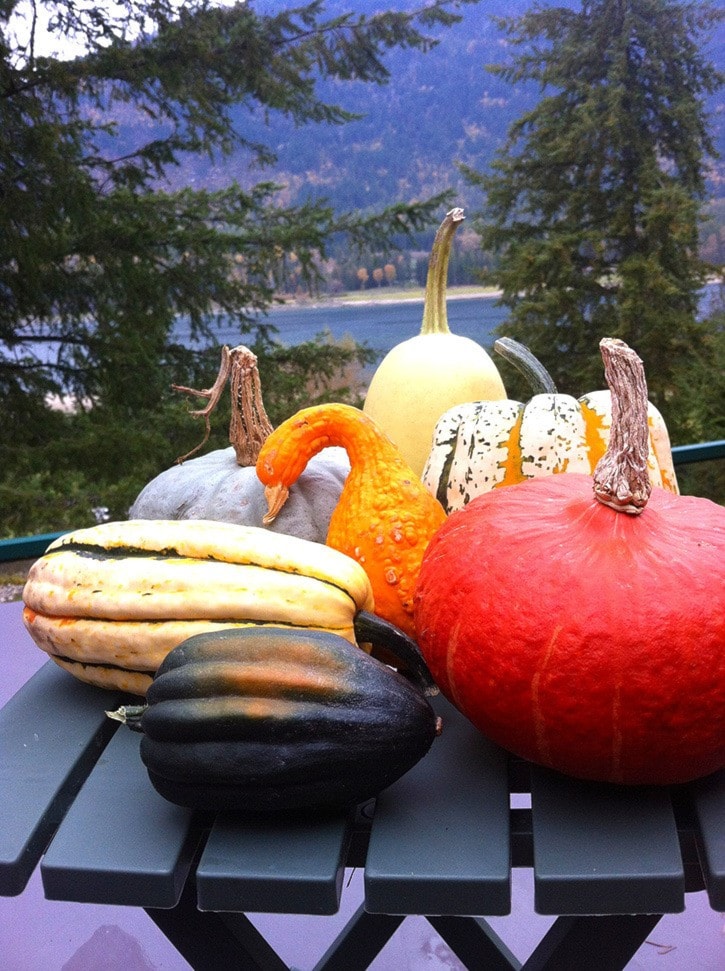Quick – name five varieties of squash before you read the next sentence!
Zucchini, patty pan, hubbard, pumpkin, delicata, acorn, crook neck, butternut, spaghetti, buttercup, Hokkaido, turban, winterhorn, trombone, and Bennings green tint to cite just a few.
The external beauty of squashes in autumn always gets me. I love the colour variety, the shapes and the various size differences. To be honest, other than baked acorn squash and Jack O’Lanterns at Hallowe’en I have never been much of an aficionado or paid squash that much attention until I got involved with the Vegibox.
As the curator of our weekly varietal produce boxes, I have the challenge and the pleasure of researching all of the local fare and choosing what to purchase for our group of customers. Squashes of different varieties have been an available choice going back to the middle of July. Being a Vegibox subscriber myself, I was presented with the opportunity to learn more about this.
In summer, we see more of the ‘young’ or immature squash most readily identified by the edible skin. Summer squash varieties include green and yellow zucchini, patty pans, white flat, sunburst, and crook neck.
Squash offers a healthy dose of Vitamin A and a respectable amount of vitamin C. It is easy on digestion, low on the glycemic index and contains a mere 82 calories per cup.
I started the research for this column by looking up the origin of the word squash. Why do we call it that? Turns out, it is a short form of the Massachuset Indian word askutasquash, meaning “eaten raw or uncooked.” Which led me to wonder where we got the word pumpkin. Pumpkin comes from an old French term pompion, meaning eaten when “cooked by the sun,” or ripe. In modern French, pumpkin is called potiron or citrouille.
Squash originates in the Western Hemisphere and was cultivated by early North and South Americans. It has spread worldwide with the exception of Northern Europe and Great Britain, presumably because it requires a fair amount of hot weather to grow.
Most summer squash can be eaten raw or lightly grilled, steamed, sautéed or stir-fried. One of my favourite dishes is sliced zucchini sautéed with whole mushrooms in butter and garlic. Winter or hard-skinned squash works well pierced and then oven-roasted whole with the seeds removed prior to serving. To tempt kids to eat squash, it can be mashed with butter and brown sugar and served alongside their favourite meat dishes.
Roasted Squash and Braised Kale
Tips: roast the squash a few hours ahead of time (then reheat) but cook the kale just before serving- it Preheat oven to 425F.
Ingredients
4 cups peeled and cooked squash (butternut or similar)
1 acorn or delicata squash, cut into rings
1 red onion, sliced
Fresh thyme springs
Olive oil
Sea salt and ground black pepper
1 bunch kale
2 slices bacon, chopped
2 garlic cloves, minced
1/3 cup dry white wine
Place both types of squash in a large bowl and add onion and thyme. Drizzle with oil and generously sprinkle with salt and pepper. Toss, then spread out on a baking sheet. Roast in preheated oven until squash is tender, about 15 to 20 minutes. Meanwhile, cut out large centre ribs and stems from kale. Cut leaves cross-wise into thick slices. In a large, wide frying pan, sauté bacon over medium heat. When crispy, add garlic and cook until light golden, about one minute. Remove to a small plate but leave bacon fat in pan.
Increase heat to medium-high. Add kale and stir-fry for one minute to absorb bacon fat. Pour in wine. Stir constantly until kale has wilted, five minutes. Move to a large bowl and add bacon and garlic. Add cooked squash and onions. Toss to mix. Place on a serving platter.
